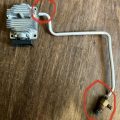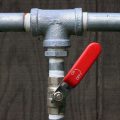People often wonder whether it is possible to use PEX piping for compressed air, as it is typically found in plumbing installations. In short, it is possible, but you must understand the various types of PEX and which one is suitable for the job.
This article will provide you with all the relevant information on the various types of PEX pipes and whether you can use them for compressed air.
Table of Contents
- What is PEX?
- Types of PEX Pipe
- Using PEX for Compressed Air
- How Do You Make PEX Connections?
- PEX vs Copper or CPVC – Which is Better?
- Youtube Demonstration Reviews
- Using PEX for Compressed Air Summary Advice & Tips
- FAQs (Frequently Asked Questions)
What is PEX?
PEX is a modified version of polyethylene (PE) where the molecular structure has undergone a change. The polymer chains have been cross-linked (X) so to speak to create a three-dimensional flexible structure.
For much of the latter 20th century, household plumbing systems depended heavily on copper piping – a material that can be difficult to master and whose price has risen significantly in recent years with its ever-increasing demand. This has therefore led to many pros and DIYers opting to use PEX tubing.
PEX is cheaper than copper and steel for instance, as well as boasting the advantage of being flexible/bendable. This means that compared to the straight rigid metal materials, PEX requires fewer connections and fittings, which enable the installers to get the job done a lot faster and with far more ease.
On top of this, once installed, PEX tends to fare far better over the long haul because the plastic is so durable it resists the mineral buildup and corrosion that copper will often undergo. PEX also stands up admirably better in freezing temperatures, compared to metal pipes that can freeze and in severe conditions, explode/burst.
Of course, PEX has disadvantages though, it remains poorly understood by any normal person. This is due to the unfamiliarity on how to cut, crimp and clamp the material with specialty tools.
PEX is available in a wide variety of lengths, from short 10-foot pieces to rolls that reach lengths of 500 feet, used for a home’s entire water supply system. PEX pipes then to rang in 3/8″ to 1″ in diameter and can be color-coded, making it easy to pick up the suitable pipe for your desired application. That being said, aside to color-coding, there are around 20 different variations of PEX piping which we’ll get into later in this article.
Typically PEX is color-coded in plumbing applications as:
- Blue PEX pipe carries cold water
- Red PEX pipe carries hot water
- White PEX pipe can be used for either cold or hot water
- Grey PEX pipe can be used for either cold or hot water

PEX Piping Advantages
Let’s take a look at some of PEX’s key advantages beyond just its flexibility.
- PEX piping doesn’t require soldering or welding as does copper and galvanized steel systems
- PEX piping does not corrode, which is very likely with copper and steel pipes, which leads to contamination and potential leaking
- PEX piping expands, making it more resistant to freeze-cracking than either copper or steel
- Water flows silently through PEX piping, which eliminates the “water hammer” noise associated with metal piping
- For water supplies, the color-coding makes it simple to distinguish hot and cold supply lines
- PEX piping can be connected to existing metal supply lines with the correct fittings
PEX Piping Disadvantages
And some of its most notable disadvantages include:
- PEX piping is not suitable for outdoor use. This is because UV (ultraviolet) rays can cause PEX to break down rapidly- likely hardening and then cracking if left outdoors
- PEX is not recyclable, because it does not melt as other plastics do that are recyclable. An increase in PEX popularity will lead to a demand for a way to recycle it.
- Working/installing PEX piping requires special connectors and tools
Types of PEX Pipe
As already mentioned above, there are over 20 variations of PEX pipe but we won’t get into all of them don’t worry! We’ll focus on providing a basic understanding of the 4 main types which are:
- PEX A
- PEX B
- PEX C
- PEX-AL-PEX
Let’s look at each in more detail!
PEX A
PEX A is the strongest, most durable, and most flexible of the PEX types. It boasts a unique ability to recover from kinks that others may find difficulty in. Normally, if a section of the tubing becomes damaged or deformed, you’d have no choice but to remove and replace it.
PEX A, however, allows you the capability to use a heat gun to restore its original state. PEX A is a great material choice for tight spaces and parts that are difficult to reach. PEX A can be relatively more expensive than B or C subsequently.
PEX A is cross-linked using an “Engel” process which involves introducing peroxides to the polymer prior to forming it. This process allows more bonding at the atomic level, resulting in the highest degree of cross-linking, which aids its strength features.
PEX B
If your project involves little tight turns, and long straights run, you can save a lot of money by opting for PEX B. This type of PEX tubing trades its flexibility for rigidity and excels its counterparts in a number of common applications.
The real downside to the stiffness is that PEX B will break in situations where PEX A bends rather easily. This limits its utility and can significantly complicate the installation process.
PEX B has a “silane” process that is conducted after the polymer is extruded into the tube. IT passes the finished product through steam in the presence of a silane catalyst, encouraging the polymers to form their cross-links.
PEX C
PEX C is pretty interchangeable with PEX B. Their only real practical difference is their relative hardness. PEX C is slightly softer of the two and for this reason, it becomes more vulnerable to kinks.
Due to PEX undergoing a slightly different manufacturing process, which makes the material typically costing less than PEX B. The cross-linking process in PEX C is initiated by subjecting the polymer to an electron beam or gamma radiation. This method is not as common as the first two methods and you may not run into PEX C as commonly.
PEX-AL-PEX
PEX-AL-PEX, also known as aluminum-barrier PEX, is the most expensive of the bunch but, the most suited for use in compressed air systems. It features a very unique structure where an aluminum layer is sandwiched by 2 layers of PEX.
The aluminum layer helps the tubing keep its shape once bent. This means that PEX-AL-PEX eliminates the need for the installer to employ tie-downs every few feet. In addition to this, the aluminum layer doubles as an oxygen barrier, PEX-AL-PEX often plays a role in heating systems whose components may corrode if exposed to oxygen.
Using PEX for Compressed Air
PEX has become a popular choice for compressed air systems as it is cheap and affordable compared to your more typical, and far more expensive, metal piping compressed air systems.
PEX pipe for compressed air systems allows you to not need as many connections between the piping and the ability to run a very long length of pipe with little worry. PEX pipe is naturally more resilient against temperature fluctuations than other commonly used materials, boasting the ability to withstand extremely cold temperatures that other materials may burst in.
PEX is not rated for compressed air, but instead as water pipes. There are very few PEX pipes that are sufficient to use with compressed air, more often than not because specifications are not provided. It’s crucial to check the pressure ratings of the pipe and compare them with the compressor to ensure it’s suitable to use.
It is therefore strongly advised that out of any of the PEX types, PEX-AL-PEX is the one best for use in compressed air systems as it can deal with the high pressures due to its little or no vapor permeability.
PEX-AL-PEX takes great advantage of the chemical and corrosion-resistant properties of the PEX layers in a combination with the pressure abilities from the aluminum layer. You, therefore, are left with a pipe material that boasts great flexibility, bendability, corrosion resistance, and resistance to oils.
How Do You Make PEX Connections?
In order to make either watertight or airtight connections with your PEX pipe, you will need to obtain the right tools and supplies. I will provide you with five methods for connecting the pipes. The fittings and connectors must be an exact match to the size of the PEX pipe.
There are hundreds of types of fittings available for connecting PEX to existing copper or steel pipe, that make connections to fittings. These fittings are usually made of brass. You may also be able to acquire fittings that are also available for connecting pipes of different sizes.
The five methods are used to make connections watertight and airtight:
- Compression Fittings
- Copper Crimping
- Expansion Connections
- Push-Fit Connections
- Stainless Steel Cramps
Now let’s take a look at each method in more detail!
Compression Fittings
These types of fittings involve slopping a threaded brass nut over the end of the PEX tube, followed by a tapered plastic compression ring. A hollow brass tube is then inserted into the end of the PEX tube.
The whole thing is then inserted into the end of a threaded fitting and the threaded brass nut is then screwed onto the end of the fitting. The nut squeezes the plastic compression ring against the end of the brass fitting to create a tight seal when it is tightened.
Copper Crimping
Probably the most common way to connect PEX pipe is using copper crimping rings, which also require a special PEX crimping tool. They work by a copper ring slipping over the end of the PEX tube with a fitting inserted into the tube.
The copper ring is then pushed to the end of the tube, over the fitting, and the PEX crimping tool is used to crimp the copper ring and tube together tightly.
Expansion Connections
Another popular method is the expansion on, which uses a special PEX expander tool to stretch the diameter of the PEX tubing before inserting the end of a fitting. The PEX tube then naturally shrinks back to its original size which creates the watertight and airtight seal around the fitting.
Push-Fit Connections
The easiest and quickest way to connect PEX is with a push-fit connection, which involves special push-fit fittings that simply grab onto the end of the PEX pipe when inserted over its ends.
These types of connections require no special tools, however, removing them from the end of the pipe can be quite difficult as you need a special removal ring.
Stainless Steel Clamps
The stainless steel clamps method of connecting PEX tubes together involves using a ratchet clamping tool to tighten stainless steel rings around the PEX connections. Similar to the copper crimping method, the steel ring is slipped over the PEX tube before the fitting is inserted. The ratchet clamping tool is then used to squeeze a tab on the ring, which then tightens the ring securely around the tube and the fitting.
It is strongly recommended that for the best connections possible, you should use only the recommended tools for making the connections. You won’t get an airtight fit if you attempt to make the connections using pliers to crimp connection rings rather than a special PEX crimping tool. In addition to this, you should also always use a PEX cutter to make clean end cuts that will be easier to work with.
This youtube video below guides you on how to make your PEX connections, providing you with how to correctly use your tools. The YouTuber uses the crimping method which is very easy to follow.
PEX vs Copper or CPVC – Which is Better?
People often wonder whether PEX is better than the most popular and traditionally used piping material, copper. There are several advantages that PEX holds over copper piping which make it very attractive for creating a new piping system or replacing existing pipe systems.
The first advantage is that PEX is cheaper than copper. 1/2″ PEX tubing costs about a third of the price of copper. This will allow you to put some of the savings into purchasing the special tools needed to install PEX fittings. If you’re doing a medium-to-large plumbing job, you will tend to save money using PEX instead of copper.
Another benefit is how much faster it is to install PEX fittings compared to the copper process. If you use a manifold and a “home-run” system (a hose to each fixture), this is super fast and easy to install. Even when installing PEX fittings in a conventional mainline and branch system, the PEX connections are far quicker than having to solder copper together.
PEX boasts the ability to not corrode, unlike copper which is suspect to corrosion. If implementing the pipes in an area with acidic water, copper can corrode easily over time. PEX supplies however are unaffected by acidic water and therefore are more suitable in these areas.
It’s possible to splice PEX fittings to your existing copper pipes, and there are several methods to do so. The easiest method does not involve soldering, which is a big time-saver. Cut out a section of the plumbing pipe and slip in a stab-in tee which will allow you to connect the PEX pipe – SharkBite is probably the most common brand that supplies stab-in tees. You must check with your plumbing inspector before burying the pipe in a wall or ceiling as some areas don’t allow stab-in fittings to be concealed.
Another method is soldering in a tee to the copper pipe and attaching a PEX supply adapter, allowing you to slip the PEX tubing over the adapter. You can also use a stab-in tee to connect PEX fittings supply to CPVC, ensure you read the label to find compatible fittings though!
When it comes to CPVC, PEX costs about the same. But there are a few reasons why PEX is the better choice. PEX, doesn’t require glue, allowing you to not have to restrict yourself to well-ventilated spaces or wear a respirator. PEX is also less likely than CPVC to burst under extreme freezing conditions. In remodeling situations, PEX is more flexible than CPVC and available in longer lengths and so, it can work better when fishing through walls.
Youtube Demonstration Reviews
This youtube demonstration below conducts tests on multiple brands of PEX tubing to see how much pressure they can withstand using a pump!
The pipes themselves are able to withstand pressures from 600 PSI up to around 1000 PSI before bursting. While the Sharkbite push to connect fittings blew off at around 475 PSI and 540 PSI. Therefore, if you’re supplying your airlines with 90 PSI (the typical amount of pressure for most air tools) then you have a safety factor well above 4:1.
This demonstration below provides you with the full breakdown of the process being using PEX for shop air and creating a network.
It begins advising you to get a pen and paper and draw out your system, where exactly you desire to run your tube, the sizing of the pipes, distribution points, and what fittings you plan to use. The Youtuber provides you with all the links to the tubing, cutter, tees, wall mounts, crimping tool, and connects so that you’re able to purchase them and replicate this kind of setup!
If you come across a PEX installation in a new house you move into or you have someone do an installation for you, there are certain checks you should conduct to ensure that the setup is correct. This video below gives you a great idea of what to look for and what a bad PEX installation looks like.
Using PEX for Compressed Air Summary Advice & Tips
If you’re planning to use PEX, or should I say PEX-AL-PEX, for your air compressor piping setup, I would like to leave you with the following tips:
- First of all, ensure that the PEX tubing is adequately pressure rated for the pressure of your compressor, or the compressor you intend to purchase. Preferably exceeded the working pressure of your compressor significantly.
- Run the PEX system indoors and away from direct UV light spots to avoid pipe degradation.
- Only use the recommended PEX connections and their specific tools e.g. crimping connecting ring and PEX crimping tool. Also, PEX cutters to ensure you make a clean cut on the pipe if it is required to do so.
- Insert a filter, or multiple filters, at suitable points in the system to remove moisture and other contamintants (just before the end use is typically the best place)
FAQs (Frequently Asked Questions)
PEX pipes are available in sizes between 3/8″ to 1″ and you can use any size within this for compressed air systems, it is totally dependent on your preference or the size of your air tools/compressor. Though it is possible to get adapters to connect differently sized tubing to tool or compressor connections, it is generally not advised because you will encounter pressure drop at these adapters.
Yes you can use PEX pipe for compressed air if you’re using the right type of PEX pipe. Typically, you need to find a PEX pipe that is capable of withstanding the pressures in compressed air systems. Though most PEX pipes will have pressure ratings well above that of an air compressor, it is important to pick out a PEX pipe that is rated for compressed air systems, like PEX-AL-PEX. This material can deal with the high pressures in compressed air systems as it has little vapor permeability if any.
PEX pipe is a type of plastic pipe made from a material which is a modification of polyethylene (PE), where the molecular structure has been changed by cross-linking (x) the polymer chains. This creates a three-dimensional flexible structure. PEX pipe requires fewer connections and fittings compared to copper and steel, which will enable users to install the PEX pipe system a lot easier and faster. PEX pipe is also cheaper than them and provides you the advantage of it being bendable.
PEX A is the far more flexible material between the two, and it has little or no coil memory, giving the installer the ability to repair kinks with a heat gun. PEX B however, is stiffer and so, noticeably harder to bend. Any kinks in PEX B pipe can only be repaired by cutting the pipe and installing a coupling.
Though they both have similar resistance to oxidation, PEX A has a high rate of chemical leaching making it a concern for plumbing installations. PEX B is a clear winner in terms of its price and that it has a higher bursting pressure, which is very important for plumbing installations.
This depends on the exact brand and type of PEX pipe you purchase, but typically PEX pipe can withstand pressures of around 600-800 PSI and even up to 1000 PSI in some cases. When dealing with compressed air systems that provide your tools with 90 PSI (average standard tool requirement) then you have a very suitable safety factor.
If you have any questions regarding using PEX pipe for compressed air, please leave a comment below, with a photo if applicable, so that someone can help you!





